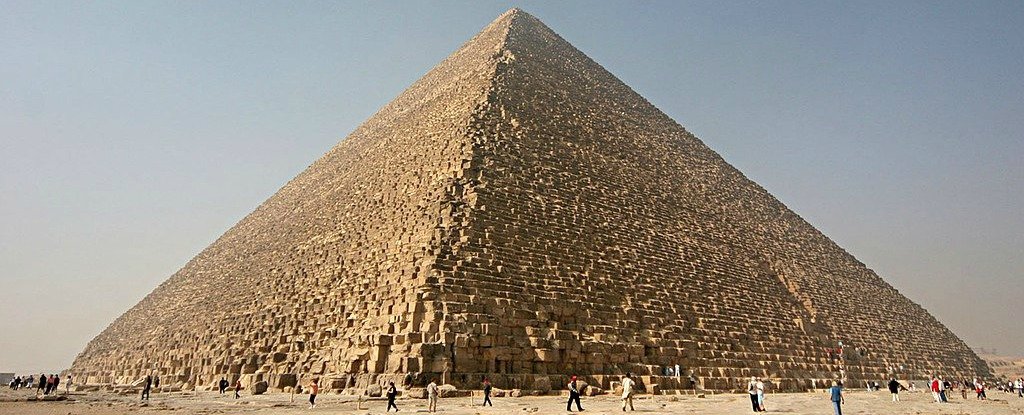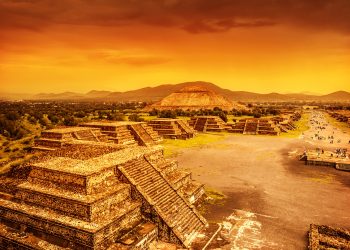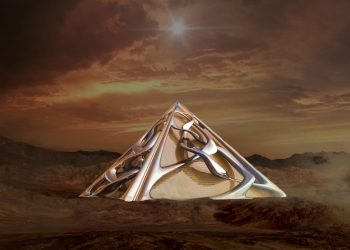Ask any historian about the Great Pyramid of Giza, and their answer will be it was a majestic monument built as a tomb to house the remains of the Pharaoh. The Great Pyramid of Giza, also called the Pyramid of Khufu or the Pyramid of Cheops, is the oldest and largest of the three pyramids, standing proudly on the Giza plateau in Egypt.
1) Why it may not be Khufu’s tomb
As the oldest of the seven wonders of the ancient world, this majestic structure is perhaps the most fascinating of them all. But why Khufu? And why do Egyptologists think it is a tomb? The answer may be rather simple. Based on a mark found in an interior chamber of the pyramid, some experts believe the symbol refers to the fourth-dynasty Egyptian pharaoh Khufu.
That is the only mark that has ever been found in the pyramid. No other marks reference Khufu, nor do any other symbols suggest the pyramid was his eternal resting place meant to protect him in his journey to the afterlife. Given that lonely and ‘miserable symbol, Egyptologists argue that the Great Pyramid of Giza was thus built as a tomb over a 10- to 20-year period concluding around 2560 BC. But no discovery other than that symbol suggests Khufu’s mummy was ever inside the pyramid.
The mummified remains of King Khufu have never been found and are presumed to have been stolen from the Great Pyramid. But that’s just a theory. His mummified remains may very well remain hidden in a burial chamber in a different part of Egypt. But there’s more to the pyramid than we’ve ever thought possible, and some of the more recent discoveries made by experts could change everything we know about it and its true purpose.

Evidence
The idea that the Great Pyramid of Giza was not built as a tomb has aroused the interest and imagination of numerous researchers and writers. What if, for some crazy reason, the Egyptians built the Pyramid(s) to serve a completely different purpose? Egyptologists argue that building the pyramid in 20 years would involve installing approximately 800 tons of stone daily. It was a massive project. In the past, it was believed that the pyramid’s builders were slaves.
However, recent discoveries have shown that the people that built the pyramids were well-paid laborers. The Great Pyramid consists of a mind-boggling 2.3 million blocks. It means that completing the monument in just twenty years would have involved moving an average of more than 12 of the blocks into place each hour, day, and night.
Yes, it was a monument worthy of a king. And it was a structure that a Pharaoh would most likely have deserved. But if there’s not much evidence, why do we continue claiming it was a tomb? Why is it wrong to think the Great Pyramid may have had a much different purpose? You would think that if the pyramid were built as a tomb for a Pharaoh, its construction process would be very well documented. After all, the Egyptians were excellent record keepers. So, why are details about the Pyramid’s construction nearly nonexistent?
2) Missing mummies of Khafre, Khufu, and Menakure
So, our experts in Egyptology say that the Pyramids were built as tombs and that the Pharaoh’s mummified remains were located inside these massive, majestic, awestriking monuments. Yet, for some mysterious reason, the interior of the pyramids lacks any inscriptions. There aren’t any hieroglyphics; there aren’t any markings. The pyramid’s interior seems pale and poor compared to its stunning, imposing exterior beauty.
So far, neither the mummified remains of Khafre, Khufu, nor Menakure have been discovered inside the tombs.
Evidence of the Pyramids not being a tomb can be found if we take a look at first-century BC historian Diodorus Siculus, who writes:
“The kings designed these pyramids for their sepulchers, yet it happened that their remains were not deposited here. Describing the Great Pyramids and the hatred their builders supposedly attracted to themselves, Diodorus follows the tradition of Herodotus; he adds, however, that their bodies were never buried in them, but rather that the rulers commanded that their bodies be placed in a secure place that was kept secret.” (C. Zivie-Coche 2002 (1997): 102).
This means that it is likely that the mummified remains of Khafre, Khufu, and Menakure were probably never inside the pyramid but rather in a secret tomb that experts have still not found.
3) Electromagnetic properties of the pyramid
A study published not long ago by scientists from ITMO University (Russia) and the Laser Zentrum Hannover (Germany) may have completely rewritten the possible purpose of the Great Pyramid. Researchers from ITMO University and the Laser Zentrum Hannover have discovered the Great Pyramid of Giza can focus electromagnetic energy and have created a model of the pyramid’s resonant electromagnetic response.
Science Alert explains that “electromagnetic radiation, including visible light, radio waves, and microwaves, is radiating waves of oscillating electric and magnetic fields, and it’s all around us all the time.” Scientists created a model of the pyramid and its electromagnetic response. They calculated the extinction cross-section and then estimated how the energy is scattered or absorbed by the Great Pyramid.
Using multipole analysis, the scientists confirmed that the scattered fields concentrated inside the pyramid’s chambers and beneath its base. “Applications of modern physical methods and approaches for investigations of pyramids’ properties are important and productive,” the scientists explained in their paper.

“It could allow [us] to make discoveries or get new information motivating new interests [in] the pyramids.” “Egyptian pyramids have always attracted great attention. We, as scientists, were also interested in them, so we looked at the Great Pyramid as a particle dissipating radio waves resonantly. Due to the lack of information about the physical properties of the pyramid, we had to use some assumptions.”
“For example, we assumed that there are no unknown cavities inside, and the building material with the properties of an ordinary limestone is evenly distributed in and out of the pyramid. With these assumptions made, we obtained interesting results that can find important practical applications,” says Dr. Sc. Andrey Evlyukhin, scientific supervisor and coordinator of the research. So why on Earth would someone build a pyramid as his tomb that somehow has extraordinary electromagnetic properties?
Have something to add? Visit Curiosmos on Facebook. Join the discussion in our mobile Telegram group.











